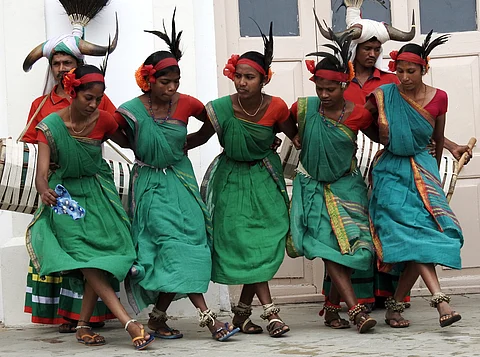

The quiet hamlet of Medaram, a village in Telangana&rsquos Mulugu district (over 240km from Hyderabad), hosts the biennial tribal festival Sammakka Sarakka Jatara. Also known as Medaram Jatara, the festival is held in the month of Magha, on Sudha Pournami (full moon day), which usually falls in the second or third week of February. The festival showcases the traditions and heritage of Koya tribal people.
The Legend Behind The Name
The festival honours a tribal uprising against the levying of taxes on tribal people during drought conditions by the then Kakatiya rulers in the 12th century, headed by mother-daughter team Sammakka and Saralamma. Millions of pilgrims converge here to seek the blessings of the warrior goddess Sammakka and her daughter Sarakka, during the fair.
The Numbers
Sammakka Sarakka Jathara is said to be the largest tribal religious festival in Asia. According to the Telangana government&rsquos records, more than 10 million devotees from Andhra Pradesh, Telangana, Madhya Pradesh, Chhattisgarh, Odisha, Maharashtra, Karnataka and Jharkhand visit Medaram during the three-day festival.
The Rituals
If you visit Medaram during the festival, you will see devotees carrying vermillion, jaggery and sacrificial animals as offerings to the goddesses. They intone songs that praise the bravery of Sammakka and Sarakka, whom they believe have the power to induce courage into their souls. Before making any offerings, it is compulsory for devotees to take a dip in Jampanna Vagu, so as to wash away their sins.
The fields around the Medaram temple spread across several acres and the surrounding villages are filled with temporary shelters meant for devotees.
On the first day of Sammakka Sarakka Jatara, tribal priests bring out the casket of vermillion, which is supposedly Sarakka&rsquos, from the forests, amidst the frenzied beating of drums, blowing of trumpets and chanting. Deities of other Koya warriors are also brought out the same day. On the second day, priests bring out the main deity, Sammaka, from Chilakkalagutta.
Devotees offer jaggery equal to their weight, to the deity. Money, saris, bangles, gold or coconuts are also offered at the temple&rsquos altar. They also sacrifice fowls and goats to the goddess. On the third and final day, priests return the deities to their respective abodes within the forest.
A River Runs Through It
Devotees take a dip in Jampanna Vagu, a tributary of River Godavari, named after the tribal warrior Jampanna who was the son of the tribal goddess Sammakka. He died while engaged in combat with the Kakatiyan Army in that stream. The Jampanna Vagu is red and the people believe that it has been inscribed with Jampanna's blood. Scientifically though, the red colour of the water is attributed to the soil and mineral composition.
Getting There
Medaram is a remote place in the Eturnagaram Wildlife Sanctuary, a part of Dandakaranya, the largest surviving forest belt in the Mulugu.
A slew of special Medaram Jatara bound trains leave from Secundrabad Railway Station to Kazipet/Warangal. From here, one can catch a Jatara-bound TSRTC bus.
Special buses are arranged by TSRTC from Warangal as well as Hyderabad to Medaram village. Medaram Bus Stand has region-specific queues for the bus service, to regulate traffic.
More information here.
ALSO READ 5 Ways To Explore Indigenous Cultures
